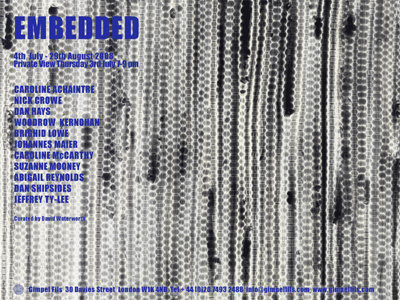Embedded
dal 2/7/2008 al 28/8/2008
Segnalato da
Caroline Achaintre
Nick Crowe
Dan Hays
Woodrow Kernohan
Brighid Lowe
Caroline McCarthy
Johannes Maier
Suzanne Mooney
Abigail Reynolds
Dan Shipsides
Jeffrey Ty-Lee
2/7/2008
Embedded
Gimpel Fils, London
Images are built out of complex processes of engagement and use, made particularly visible through the impact of new technologies as they change attitudes towards surveillance, information gathering, pornography, celebrity and so on. This exhibition examines the systems that affect such change.

curated by David Waterworth
Caroline Achaintre, Nick Crowe, Dan Hays, Woodrow Kernohan, Brighid
Lowe, Caroline McCarthy,
Johannes Maier, Suzanne Mooney, Abigail Reynolds, Dan Shipsides, Jeffrey
Ty-Lee
Images are built out of complex processes of engagement and use, made
particularly visible through the impact of new technologies as they
change attitudes towards surveillance, information gathering,
pornography, celebrity and so on. This exhibition examines the systems
that affect such change. The artists taking part can be compared to the
embedded news reporter, in that they are working from within the
processes of image manufacture. From this position, the work exhibited
is able to provide revelatory and expansive commentary on the structures
that bring images into being.
This exposure of process is often in a different medium to that being
examined. Typically, the intangible nature of digital and virtual space
is explored through plastic, tangible methods such as installation and
montage. In the work of Nick Crowe, for example, glass becomes a plane
of convergence between disparate fields in digital space. In his Aer
Lingus series, glamorised portraits of airhostesses are combined in
glass with unsolicited email from contact agencies. In a new work for
the exhibition, Nick Crowe utilises the interface provided by the
gallery window, acknowledging its materiality while offering, via a
website address, an additional engagement with a virtual scene.
Brighid Lowe's response to the structures found within systems of
exchange is physically manifested in Each Long Second, which presents a
model of aimless interconnectivity. Abigail Reynolds likewise utilises
material processes to unlock information systems. In The Grand Mutator,
a number-based crochet pattern is put through a series of mathematical
sequences, based on genome sequencing, each producing a variant form.
Physicality is fundamental to the working process of Dan Shipsides,
which uses the climber's experience of the rock face to explore visual
constructs. He collaborates with John McNamee, a visually impaired
climber, in Dolerite / Solarized Pigmatosis 2, where tangible and
visible merge as cameras attached to the climber's fingers seek their
way across the rock's surface [1]
Woodrow Kernohan, in Four Four, plays with variation between materiality
and image, drilling his way out of screen-based representation. Caroline
McCarthy cuts holes from coloured bin bags using the resulting dots to
painstakingly reconstruct a traditional still life in the manner of mass
printing. Caroline Achaintre's carpets lend a chunky substantiality to
the digital grid, but in the watercolours that inform them the structure
of the downloaded image is dissolved.
Presentational structures applied to the Internet image: the distortions
caused, the selectivity of the search engine, inform the painting of Dan
Hays. His internet journey has taken him to Colorado, to pixellated
landscapes he will never otherwise see. Jeffrey Ty Lee is concerned with
the hidden architecture of representation and investigates the picture
plane for clues to the image it holds. For Make Love to the Camera
Suzanne Mooney photographs diagrams from a manual on glamour
photography, providing a record of image manufacture that critically
examines the structures behind the final product. Meanwhile, an anatomy
of news-based imagery is revealed through the films of Johannes Maier.
His research into the embedded reporter interrogates the relationship
between producer and image. It is territory which all of the works
negotiate in examining the mechanics of image production from the
inside.
Embedded is curated by David Waterworth, who lectures at The University
of Greenwich, where he is curator of the Stephen Lawrence Gallery. He
curated Wandering Rocks for Gimpel Fils Gallery in 2006.
private view: Thursday 3 July 6-9pm
Gimpel Fils
30 Davies Street - London
Mon - Fri 10am - 5.30pm, Sat 11am - 4pm
Free admission



